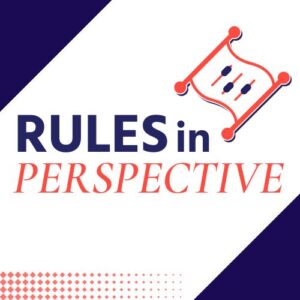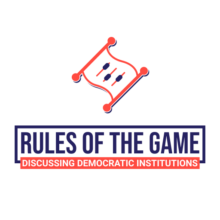
On Episode 37
Proportional Representation in Canada
Rules in Perspective is a new segment on Rules of the Game – discussing democratic institutions. In this new segment I review and comment on my own podcast episodes.
In this episode of Rules in Perspective I review the podcast episode 37 on electoral reform and proportional representation in Canada with Réal Lavergne.
My three takeaways:
- On broken promises by politicians
- On lost referendums
- On citizens’ assemblies as a reform strategy
Listen to episode 37 and find the show notes here.
It would be great to hear your opinion and feedback on this new format. If you want to send me an email, you can reach me at rulesofthegame.ddi@gmail.com. If you find my discussions interesting and you’d like to support my work, consider buying me a coffee at https://www.buymeacoffee.com/rulesofthegame
Related Episodes:
The Dream of a Truly American Democracy (Ep.1)
Proportional Representation in America? with Jack Santucci (Ep. 12)
New Zealand’s Electoral Reform with Jack Nagel (Ep. 30)
Full Transcript:
Hello! And welcome to the second edition of Rules in Perspective. Rules in Perspective is a new segment on the Rules of the Game channel, where I reflect and comment on my own podcast episodes. My name is Stephan Kyburz and I am the host of Rules of the Game – discussing democratic institutions.
In the last podcast episode I discussed proportional representation in Canada with Réal Lavergne. I learnt so much in that discussion about the progress and hurdles of advancing proportional representation in Canada. Réal has a lot of experience in the reform movement and gave great insights.
You can find Rules in Perspective both as a video on my Youtube channel and as a bonus episode on my podcast Rules of the Game and your favored platform.
It is important to mention that these are my personal comments and do not necessarily reflect the views of my guests or the organizations they work for.
Please subscribe to my Youtube Channel to not miss a future episode!
These are my three takeaways from episode 37:
First, it looks like the broken promises by politicians are the norm rather than the exception when it comes to electoral reform. This is a typical time inconsistency problem. An outsider political party has every interest in electoral reform, because it would make it feasible to win more seats.
Sometimes there is a landslide victory for such an outsider party. Then, once in power, that same party that was elected on the existing electoral law, that it criticizes, then has little incentive to change that law, because it would likely mean that they lose power.
We observe that pattern time and again in countries with a first-past-the-post electoral system and where reform attempts are made by trying to make politicians commit to electoral reform.
In the case of Canada, the democratic reform platform helped Trudeau to get in power. Before the 2015 election, his party, the Liberals, were 3rd in the polls – from that position proportional representation obviously seems like a good choice. But then you win the election and proportional representation suddenly becomes a bad choice. Trudeau was able to form a government with 39% of the popular vote, but 54% of the seats won. That’s a huge bonus. So he broke his promise to move the country to proportional representation, because he was afraid of losing that bonus. And especially the caucus members in parliament have absolutely no incentive to change the system.
The question is: how can reform movements prevent the broken electoral reform promise? I think the only way is through raising public awareness and building up political pressure.
Second, Canada has seen many lost referendums on electoral reform. As the case of Canada exemplifies, winning a popular vote on electoral reform is difficult. The one referendum that could be called successful with 58% in favor of electoral reform was the one in British Columbia in 2005. Unfortunately, specifically that popular vote had the extraordinary 60% approval threshold. So electoral reform got rejected anyway.
In Switzerland it took 3 popular initiatives to get proportional representation passed at the ballot box in 1918. The male citizens rejected the proposal twice in 1900 and 1910. So there was a lot of convincing necessary. Only in the third attempt, the voters passed electoral reform and changed the constitution with an overwhelming majority of almost 67%.
I personally think that electoral reforms should always be approved by a popular vote, even though it needs a lot of educating, discussion and convincing of the voters. Electoral reform that is passed by parliament only, always carries the risk of favoring those already in power. There is a huge risk that the dominant parties in parliament reinforce their hold onto power, which means democratic backsliding.
Importantly also to mention here is that popular votes should be bottom-up processes.
This bring me to my third point:
And that is about the change of strategy of Fair Vote Canada to use Citizens’ Assemblies as a vehicle for electoral reform. I totally understand that Fair Vote Canada wanted to come up with a new strategy after many broken promises and a number of failed referendums. It seems obvious to look for new solutions when the old ways don’t seem to work.
There was this case of a Citizens’ Assembly on electoral reform in the province of British Colombia in 2005 that is used as inspiration. It was apparently the first citizens’ assembly in the world discussing changes in the electoral system. It was exactly this citizens’ assembly that led to a result where the referendum was almost won; that referendum got approximately 58% support for the yes side. How much of that high approval can be attributed to the citizens’ Assembly I don’t know. Fair Vote Canada seems convinced though that it was an important element because it got a lot of publicity.
The remaining question here is, why should politicians implement the recommendations by a Citizens’ Assembly and how could you ensure that politicians would implement it?
In the end, a popular vote seems the appropriate institution to approve any electoral reform proposal. So I believe there is no way around campaigning for electoral reform and educating the people as much as possible, even if it takes many attempts at the ballot box.
The question of electoral reform is about raw political power. I do not see a reason why a party should follow the recommendations of a Citizens’ Assembly, when it means losing power. I hope Canada can prove me wrong. In the end, Réal and I agreed that a referendum is necessary to bring about electoral reform. If a Citizens’ Assembly is highly public and conveys public discussions, then it seems a good preparatory step for a referendum.
Thanks for listening to the second edition of Rules in Perspective. I really appreciate you’ve taken the time.
Please listen also to my other episodes on electoral reform.
In my first podcast episode ever, I discuss electoral reform in the US, and I make comparisons with the introduction of proportional representation in Switzerland in 1919. The episode is called the Dream of a Truly American Democracy.
With Jack Santucci I discuss Proportional Representation in America. He has written the book “More Parties or No Parties: The Politics of Electoral Reform in America”, and he is one of the most knowledgeable scholars when it comes to electoral reform in the US.
Finally, an inspiring case of electoral reform, especially for countries with a Westminster type system, is New Zealand. With Jack Nagel I discussed how New Zealand successfully switched from first-past-the-post to Mixed-Member Proportional system.
As always, I link to all episodes in the description below.
Please subscribe to my channel and hit the bell button to not miss future editions of Rules in Perspective, and more upcoming videos on democratic institutions.
